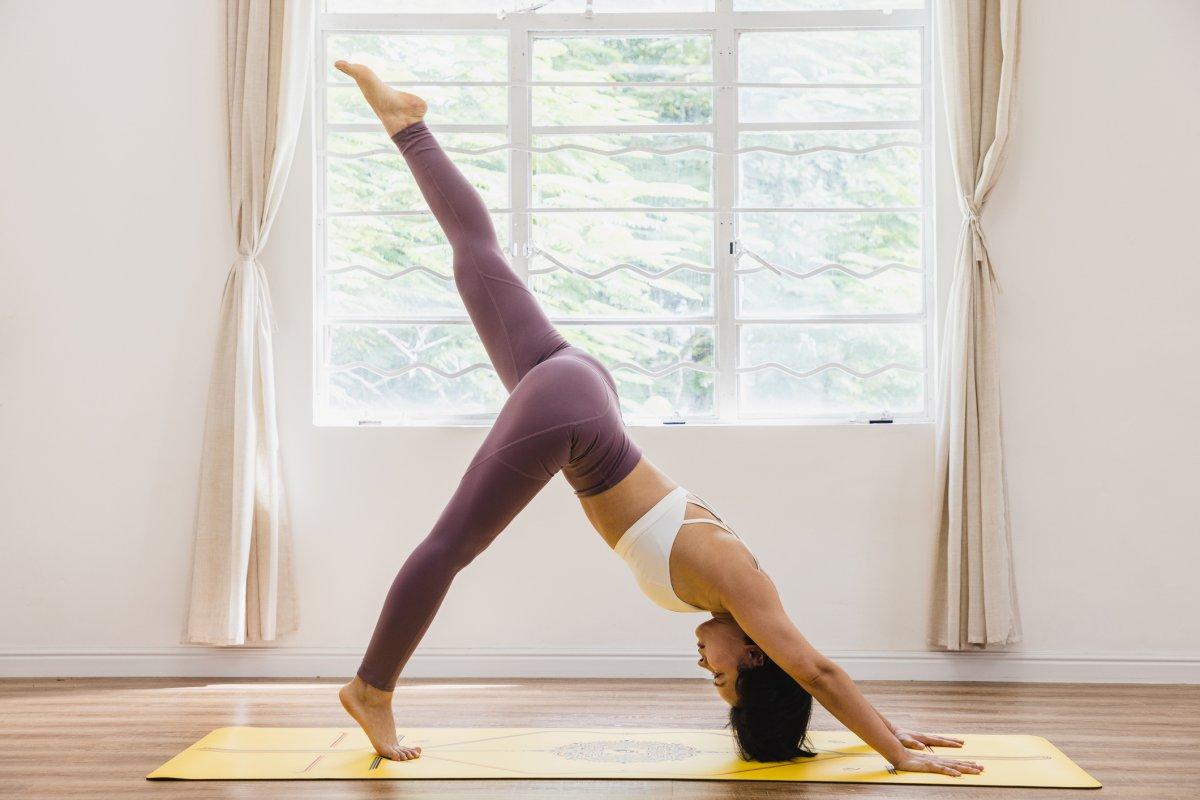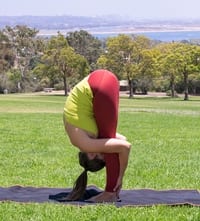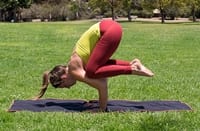Curious about inversion yoga? Learn how to do some of the essential poses in this guest post by San Diego teacher Tiffany V...
Have you ever considered flipping your world upside down? We’re not talking about literally turning your life on its head. Instead, why not try something new and explore the benefits of inversion yoga?
An inversion is a yoga pose that turns the body upside down, where the head is below the heart. This can be done in many different poses, such as handstands, shoulder stands, and even headstands.
Intrigued? Read on to find out more about the unexpected benefits of inversion yoga!
What Are Inversions in Yoga?
Inversions in yoga are postures that involve the body being upside down relative to its normal orientation. Here are more details:
- These postures can be empowering and allow practitioners to explore a new perspective on their practice.
- Examples of these postures include handstands, headstands, and shoulder stands.
- In inverting the body, yogis reverse the effects of gravity and everyday physical stress on their bodies. They also often find greater freedom and energy which can help them relax, improve blood flow, and relieve muscle tension.
- Inversions can add an extra element of challenge and mindfulness to any yoga practice, allowing practitioners to push themselves in a safe and supportive way.
Are you ready to start learning more about the inversion postures yoga practitioners should know? Sign up for yoga classes! There are all kinds of yoga inversions beginners can safely do – you can learn more about the benefits of yoga classes by watching the video below:
https://www.youtube.com/watch?v=tFrPtU8lwN0
What are the Benefits of Yoga Inversions?
Inversions have many physical and mental benefits that make them an important part of any yoga practice.
Physically, inversion poses stretch out tight muscles and joints while boosting blood circulation throughout the body. This helps reduce fatigue and increases energy levels while also improving digestion. Additionally, inversion poses can help relieve stress by calming the nervous system and reducing tension throughout the body.
Mentally, inversions can be beneficial for focus and concentration as well as decreasing anxiety and depression symptoms. When inverted, there is increased blood flow to the brain which helps sharpen focus and encourages mindfulness. It also provides a sense of clarity which helps clear away negative thoughts or worries for improved mental clarity and wellbeing overall.
If you’re new to yoga or just starting out with inversion poses, it’s important to start slow by practicing beginner poses like Downward Dog or Child’s Pose before attempting more advanced postures like Headstands or Handstands. Always listen to your body when practicing any pose; if something doesn’t feel right or causes pain then stop immediately and seek professional guidance from an experienced instructor who can provide modifications as needed for safe practice.
What Are the Risks of Yoga Inversions?
It’s important to note that certain health conditions may limit your ability to safely practice inversions.
If you have neck or back pain or any cardiovascular issues, you should consult with your doctor before attempting any kind of inverted position. It’s also important to pay attention to any sensations while practicing an inversion—if you experience dizziness or lightheadedness during the pose, come out immediately and rest until those symptoms subside before continuing on with your practice.
Finally, if you have high blood pressure or glaucoma or are pregnant, it’s best not to attempt any kind of inverted pose without consulting with a medical professional first.
3 Different Types of Inversion Yoga Poses
We are so used to viewing life from a “right-side-up” perspective, where we soak in the world around us by way of our sensory organs (eyes, ears, nose, and mouth). We process everything upstairs, allowing it all to accumulate to form our point of view, which in turn fuels our decisions, reactions, and movements down to our toes. Rather than taking the time to sort through and scratch away at all this clutter with a mental stylus, an inversion can shake things up, reset, and clear away tension and stress as easy and fast as erasing a messy linear creation on an Etch-A-Sketch.
1) Heating, invigorating, revitalizing (head below the heart):
We are so used to viewing life from a “right-side-up” perspective, where we soak in the world around us by way of our sensory organs (eyes, ears, nose, and mouth). We process everything upstairs, allowing it all to accumulate to form our point of view, which in turn fuels our decisions, reactions, and movements down to our toes. Rather than taking the time to sort through and scratch away at all this clutter with a mental stylus, an inversion can shake things up, reset, and clear away tension and stress as easy and fast as erasing a messy linear creation on an Etch-A-Sketch.
BENEFIT:
Increased circulation: When you invert gravity, it causes your circulatory system to shift the direction it flows, bringing increased levels of blood and oxygen down into your head. This fresh blood and oxygen serves as a cleansing, rejuvenating wave that increases mental functioning, and improves concentration, memory, and processing abilities in your brain.
– Start standing pressing both of your feet firmly into the ground
– Bend at your waist and grab onto your thighs, calves, or shins
– Roll your forearms behind your legs, inhale and lengthen your spine, then exhale, pulling down with your arms to draw your chest closer to your thighs
– Bring the weight into the ball mounds of your feet and use your breath and arms to continue to get deeper into the fold, striving for straight legs
– Hold for 30 seconds to 1 minute
– Rise out of the pose very slowly
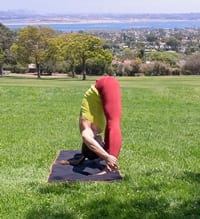 Wide Legged Forward Bend (Prasarita Padottanasana)
Wide Legged Forward Bend (Prasarita Padottanasana)
– Stand with your legs wide, feet facing forward and paralleled to each other with your arms out wide
– Take an inhale breath to lengthen your spine up by reaching your head high, then exhale fold with a flat back, reaching your hands to the outer edges of your legs or ankles
– Draw the weight into the ball mounds of your feet and press your hips up as you reach your head down
– Pull with your arms to lengthen your spine on your inhales, and fold deeper on your exhales
– Hold for 30 seconds to 1 minute
– To come out spread your arms wide like wings and elevate all the way up with a flat spine
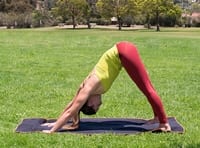 Downward Facing Dog (Adho Mukha Svanasana)
Downward Facing Dog (Adho Mukha Svanasana)
– Start in high plank with your wrists directly under your shoulders and your legs hip-width distance with shoulders, hips and ankles all in one line
– Press into your palms to lift your hips into an inverted “V” shape
– Keep your hands spread really wide and press your chest back toward your thighs
– Roll the eyes of your elbow up and out so that your shoulders roll down and in toward each other
– Lift your hips high while energetically stretching your heels toward the ground
– Let your head and neck hang heavy between your arms
– Engage through your abs to lift your lower belly up
– Hold for 30 seconds to 1 minute
– To come out walk your feet up toward your hands and roll up to standing
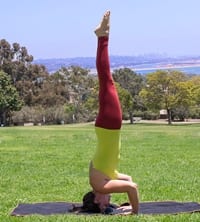 Tripod Headstand (Sirsasana II)
Tripod Headstand (Sirsasana II)
– Start sitting on your knees with your hips on your heels
– Place your hands on the ground directly on the outside of your legs with your fingers pointing forward aligned with the front of knees
– Bend forward and place the crown of your head onto the ground where it naturally falls in front of you, forming a triangle with your hands
– Press your hands firmly into the ground to take most of the weight out of your neck and energetically squeeze your elbows in toward each other to form a nice stable base
– Use your core to hug your knees into your chest and then slowly lift your legs up above you pointing through your toes
– Hold for 30 seconds to 1 minute
– To come out bring your knees back into your chest and slowly descend back down to kneeling and slowly roll your spine up to bring your shoulders back over your hips
2) Cooling, calming, relaxing (feet above the hips):
BENEFIT:
Increased circulation & lubrication of joints: The same reversed wave of fresh blood and oxygen helps increase circulation and lubrication of your hips (our most important, highest functioning, and most mobile joint in the body) and in turn works to relieve tension and stress stored in them from sitting. This also relieve pressure from bearing our body’s weight all the time as we walk, run, and jump.
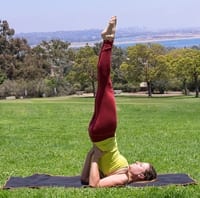 Supported Shoulder Stand (Salamba Sarvangasana)
Supported Shoulder Stand (Salamba Sarvangasana)
– Start lying on your back
– Slowly roll your legs up to stack your hips over your shoulders
– Bring your elbows behind you at shoulder distance and press them down into the ground
– Place your hands onto your lower back for support and walk them down your back to assist with the lift
– Point your toes and press your feet up and away from you as you bring your hips toward your face so your legs are stacked straight up
– Slightly tuck your chin keeping pressure off your neck
– Breathe and hold for 30 seconds to 1 minute
– To come out release your arms and slowly roll your spine back down to the ground
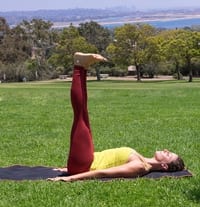 Legs up the wall (Viparita Karani)
Legs up the wall (Viparita Karani)
– Start lying on your back with your arms down by your sides, palms pressed into the ground
– Slowly lift your legs up stacking your feet over your hips
– Press your hips, shoulders, and hands down into the ground as you flex your feet and press them up toward the sky keeping your hips connected to the ground
– Engage through your abs to draw your belly button down toward the ground
– Gaze directly up to keep your neck a long extension of your spine
– Hold for 30 seconds to a minute
– To come out slowly bring your legs back down
3) Arm balancing (weight on hands):
BENEFIT:
Improved balance & strength: Once you master balancing on your feet (or foot), the next level is balancing on your hands. Know that with practice and mental strength your body can and will support you. Each time you work into the pose, even if it’s only halfway or with the use of props, you prep and strengthen the body to one day fully go there and rock it! Be patient. These poses, especially handstand, take people several months or years to accomplish.
Discovering the unknown: By shifting your perspective you literally get a chance to view your life from a different angle giving you a chance to explore the unknown of your world on the flip-side. Everything looks and feels a little different upside-down. Most people experience a little fear or anxiety about going there. If that is you, start simple and work up to the more intense poses. Find comfort in knowing that these inversions are a lot safer and calmer than say, flipping on the “zipper” at your local carnival or amusement ride, but can be just as thrilling. Once you learn to trust your strength you can easily conquer these inversions, and any other challenges in your life that might seem a little “upside down.”
Have fun! Playing around with these inversion yoga poses, especially headstand, handstand, and crow (all shown and described below), bring fun and lightness into your life and teach us not to take everything so seriously. They keep us humble and playful amid all the responsibilities and pressures of life we face day to day.
– Start in Downward Facing Dog (shown above)
– Walk your feet up and place them about six inches directly behind your wrists
– Bend your arms back directly toward your legs so your forearms are in line with your shins to act as a shelf for them to rest on
– Draw your knees as far up into your armpits as you can, with an option to hug your knees around your arms if that is more comfortable for you
– Gaze about six inches out in front of you and distribute your weight into your hands
– Come high up onto your toes and lift your hips up over your shoulders
– Engage your abs to bring lightness into your torso
– Start by lifting one foot off the ground at a time to get a feel for balancing on your hands
– Then play with lifting both toes off the ground and draw them together to touch behind you
– Breathe and hold for desired amount of time
– To come out slowly bring your feet back to the floor
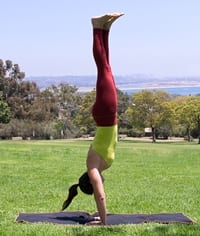 Handstand (Adho Mukha Vrksasana)
Handstand (Adho Mukha Vrksasana)
(I recommend practicing this up against a wall to bring strength into the pose before trying it freestanding)
– Bend down and plant your palms firmly down onto the ground and grip the ground with your fingertips to form a hand lock
– Roll the eyes of your elbows out like you are turning the cap off a jar with your hands
– Bring your right foot behind your hands, centered between your palms, and lift your left foot up back behind you
– Take an inhale breath and bend into your right leg
– As you exhale press into the ground and kick your left leg up to bring your hips directly over your shoulders (You will most likely need to kick harder than you think to propel yourself far enough over your hips)
– Lift your right leg up to meet your left
– Draw your head directly down toward the ground and gaze straight ahead
– Squeeze through your glutes, pike your hips slightly forward to align your spine, and engage through your core to roll your ribs closer to one another as you extend your legs up away from the ground
– Breathe and hold for desired amount of time
– To come out of it slowly bring your feet back to the ground
How Do I Start Inverting Yoga?
Taking the first step in inverting yoga can seem daunting, but with a few simple tips it doesn’t have to be.
Before starting any new exercise routine, it is important to understand the proper form and technique for each pose.
Try consulting a knowledgeable instructor or researching inversion poses online.
Additionally, make sure to start slow when beginning inversions—your practice should not be focused on achievement of difficult postures at the expense of your body’s comfort level. To gain strength necessary for executing multiple inversions, dedicate time to training your core and upper body with conditioning exercises like planks and other targeted drills.
Once you’re ready to head upside down, focus on keeping breathing even throughout your practice and remember that no one ever became an expert overnight: progress takes dedication and patience that will pay off with centeredness and control during even the most challenging posture!
What is the Easiest Yoga Inversion?
If you’re looking to start doing yoga inversions, the Half Plough (or Half Halasana) is a great place to start. This move is much gentler than many of the other inversions out there because it only requires your upper body and legs to be inverted for a few seconds at a time.
It also gives great benefits: it strengthens the spine and shoulder muscles, releases tension in lower back regions and relieves stress. To do it, simply lie on your back with your arms stretched out to either side, then lift your feet and legs off the floor while bringing them over your head toward the mat. If clearing your head and releasing tension are what you’re after, this is definitely the way to go!
No matter what yoga inversion you find easiest, now it’s time to give these inversion yoga poses a try! Ask your yoga instructor for some tips to help you get started today.
PLEASE NOTE: Some heart conditions, neck injuries, high blood pressure cases, recent stroke, detached retina, glaucoma, and epilepsy are common ailments that should be addressed before inverting. Talk with your doctor regarding your personal safety. If dizziness, pain, or fatigue occur at any point slowly and carefully come out of the pose.
 Tiffany V. teaches meditation, reiki, and yoga in San Diego, CA. She completing the 200-hour RYT training at CorePower Yoga. Learn more about Tiffany here!
Tiffany V. teaches meditation, reiki, and yoga in San Diego, CA. She completing the 200-hour RYT training at CorePower Yoga. Learn more about Tiffany here!
 Photo by Missy N.
Photo by Missy N.
Suzy S.
